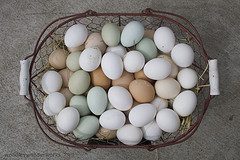

The protective antibodies induced by the current influenza vaccines are directed against the highly variable viral glycoproteins, HA and NA. Other virion proteins are far more conserved, and have been tested in experimental vaccines. For example, the nucleoprotein (NP), an internal component of the virion, is an attractive immunogen because it induces a cytotoxic T cell response that should provide protection against a broad spectrum of strains. Because the NP protein is not particularly immunogenic, DNA vaccines have been extensively tested. These are effective at inducing cellular immune responses and have met with some success, especially when coupled with adenovirus vectored antigens.
The viral M2 protein has been a focus of recent influenza vaccine efforts. This highly conserved transmembrane protein forms an ion channel in the virion, and is essential for uncoating of the viral genome in endosomes. Immunization with M2 protein has been shown to confer protection in mouse and ferret models of influenza. However, the protein is not sufficiently immunogenic. In the reports cited below, the authors examined the immunogenicity of M2 protein conjugated to carrier proteins, or presented on the surface of hepatitis B virus-like particles. The latter was effective at inducing protective immunity in mice, but not in rhesus monkeys. The authors conclude that data obtained in mice should not be used to select M2 vaccine candidates.
It seems likely that future influenza vaccines will be based on NP and M2 proteins, perhaps in combination. Significantly more work will be required before such vaccines are approved for use in humans – in the meantime, our insatiable thirst for chicken eggs will continue.
DEFILETTE, M., MARTENS, W., SMET, A., SCHOTSAERT, M., BIRKETT, A., LONDONOARCILA, P., FIERS, W., & SAELENS, X. (2008). Universal influenza A M2e-HBc vaccine protects against disease even in the presence of pre-existing anti-HBc antibodies Vaccine, 26 (51), 6503-6507 DOI: 10.1016/j.vaccine.2008.09.038

Aareal Bank in Krise
von Raivo Pommer
Trotz schwarzer Zahlen 2008 schlüpft der Wiesbadener Immobilienfinanzierer Aareal unter den Bankenschirm der Bundesregierung.
Der Finanzmarktstabilisierungsfonds (SoFFin) habe eine Stille Einlage in Höhe von 525 Millionen Euro sowie einen Garantierahmen für neue Emissionen im Volumen von bis zu vier Milliarden Euro gewährt, teilte die Aareal Bank AG mit. Dies wird aber ausdrücklich mit Vorsorge begründet.
«Wir nehmen den SoFFin nicht aus einer Notlage in Anspruch. Die Bank ist kerngesund und nichts deutet darauf hin, dass sich das in absehbarer Zeit ändern könnte», betonte der Vorstandsvorsitzende Wolf Schumacher. «Wir wollen damit eine Eisbrecherfunktion in Deutschland übernehmen.» Man habe sich mit dem SoFFin auf die Maßnahmen geeinigt, um ein «nachhaltig profitables Geschäft» dauerhaft abzusichern. «Wir haben uns einfach zwei Versicherungen eingekauft.»
Die Bank fühlt sich nach Schumachers Worten zwar stark genug, «auch gravierende Herausforderungen wie die internationale Finanzmarktkrise aus eigener Kraft» zu meistern. Er begründete die Inanspruchnahme des staatlichen Schirms vor allem mit den höheren Kapitalanforderungen an Banken. Zudem vermeide das Institut Wettbewerbsnachteile gegenüber Instituten im In- und Ausland, die bereits Staatsmaßnahmen nutzen und bleibe durch den Garantierahmen finanziell flexibel. «Der Vorstand hat vorsorglich und frühzeitig Maßnahmen ergriffen, um das Institut wetterfest zu machen.»
Aareal Bank in Krise
von Raivo Pommer
Trotz schwarzer Zahlen 2008 schlüpft der Wiesbadener Immobilienfinanzierer Aareal unter den Bankenschirm der Bundesregierung.
Der Finanzmarktstabilisierungsfonds (SoFFin) habe eine Stille Einlage in Höhe von 525 Millionen Euro sowie einen Garantierahmen für neue Emissionen im Volumen von bis zu vier Milliarden Euro gewährt, teilte die Aareal Bank AG mit. Dies wird aber ausdrücklich mit Vorsorge begründet.
«Wir nehmen den SoFFin nicht aus einer Notlage in Anspruch. Die Bank ist kerngesund und nichts deutet darauf hin, dass sich das in absehbarer Zeit ändern könnte», betonte der Vorstandsvorsitzende Wolf Schumacher. «Wir wollen damit eine Eisbrecherfunktion in Deutschland übernehmen.» Man habe sich mit dem SoFFin auf die Maßnahmen geeinigt, um ein «nachhaltig profitables Geschäft» dauerhaft abzusichern. «Wir haben uns einfach zwei Versicherungen eingekauft.»
Die Bank fühlt sich nach Schumachers Worten zwar stark genug, «auch gravierende Herausforderungen wie die internationale Finanzmarktkrise aus eigener Kraft» zu meistern. Er begründete die Inanspruchnahme des staatlichen Schirms vor allem mit den höheren Kapitalanforderungen an Banken. Zudem vermeide das Institut Wettbewerbsnachteile gegenüber Instituten im In- und Ausland, die bereits Staatsmaßnahmen nutzen und bleibe durch den Garantierahmen finanziell flexibel. «Der Vorstand hat vorsorglich und frühzeitig Maßnahmen ergriffen, um das Institut wetterfest zu machen.»
Pingback: Edwin D. Kilbourne, MD, 1920-2011
Looks like you’ve done your research very well.